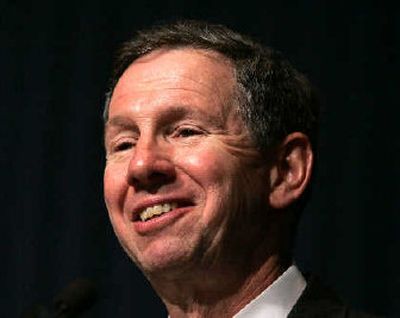NASA shuttle costs may delay Bush’s space plans

WASHINGTON – A large deficit in NASA’s troubled shuttle program threatens to seriously delay and possibly cripple President Bush’s space exploration initiative unless the number of planned flights is cut virtually in half or the White House agrees to add billions of dollars to the human spaceflight budget.
Sources familiar with ongoing negotiations between NASA and the White House say the administration has no intention of spending extra money to deal with a shortfall that some space experts say could exceed $6 billion from 2006 to 2010, when NASA plans to retire the shuttle for good.
The source of the deficit is the travail that has plagued the shuttle program since the Columbia disaster in 2003. After a single flight by Discovery this summer, the orbiters – grounded for 2 1/2 years after Columbia – are out of action again until at least May while engineers work to make them safer.
One option being considered to close the shortfall is to limit the number of flights to two per year – 10 in all – and cut the work force. But shuttle program manager Wayne Hale said on Tuesday that “frankly it doesn’t save you very much money. … From my point of view, that’s a non-starter.”
NASA Administrator Michael Griffin has said that terminating the shuttle program would be just as expensive as keeping it going. The shuttle routinely consumes more than 30 percent of NASA’s budget.
The impasse has put the future of Bush’s “Vision for Space Exploration” in doubt less than two years after it was announced. Without extra money, experts say, NASA could have trouble developing a new crew exploration vehicle by 2014, as originally planned, let alone fulfilling Griffin’s wish to fly it by 2012. The dilemma is also fueling an odd confrontation between the administration and Congress, where once-wary lawmakers now appear willing to provide the extra funding even as the White House backs away from its own initiative.
“The decisions made over the next few weeks will determine whether the Bush White House is serious about supporting the vision,” said John Logsdon, director of George Washington University’s Space Policy Institute. “We’ve reached a watershed.”
The cornerstones of the Bush initiative, announced in a speech on Jan. 14, 2004, are to use the shuttle to finish the International Space Station by 2010, develop the crew exploration vehicle by 2014, return humans to the moon by 2020 and eventually move on to Mars.
Bush called the plan “a journey, not a race,” to be completed without appreciable increases in NASA’s budget.
Initially, Congress expressed suspicion that the initiative was either a grandiose but empty gesture or a risky project that would cannibalize established NASA programs to raise the needed funding. Last year, it took an 11th-hour arm-twist by then-House Majority Leader Tom DeLay, R-Texas, to win passage of NASA’s $16.1 billion budget, but this year lawmakers easily passed the 2006 budget for the full $16.5 billion the White House requested.
The difference was that Griffin, confirmed in April of this year, earned congressional trust by reorganizing NASA and segregating the shuttle and exploration vehicle programs from the rest of NASA’s portfolio.
Sen. Kay Bailey Hutchison, R-Texas, chairman of the Science and Space Subcommittee, said on Sept. 19 that she “will do everything possible to keep the shuttle and crew exploration vehicle programs on course,” and her words have come to encapsulate the dilemma now facing NASA.
Under the budgets projected for the next five years, experts agree, it will be impossible – by several billion dollars – to complete the planned shuttle missions and finish the new spacecraft by 2012, or maybe even by 2014.